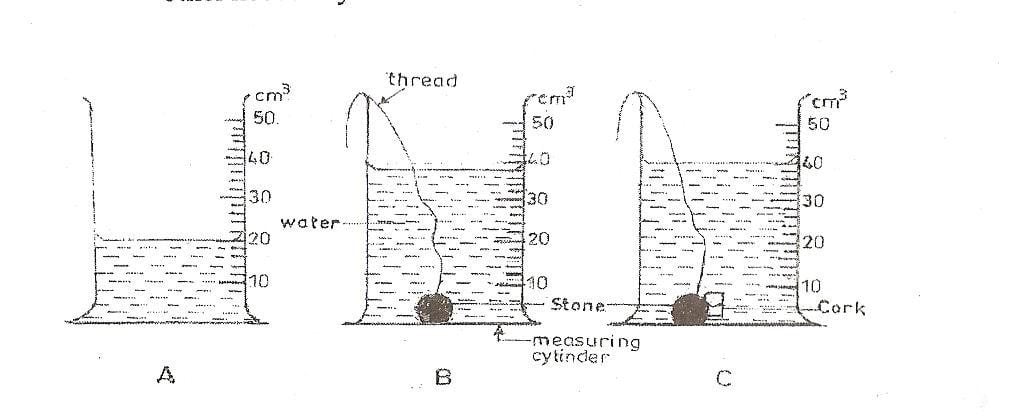BECE Past Questions & Answers – 2012 (Science)
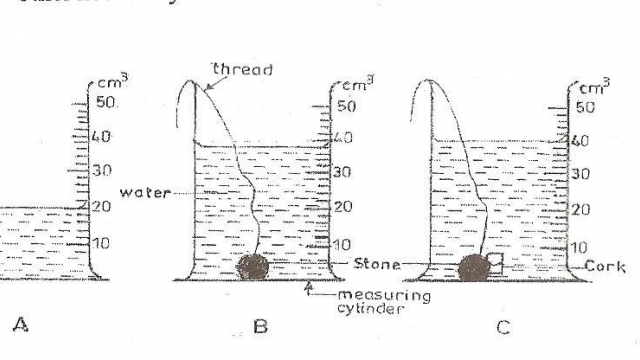
April2012
INTEGRATED SCIENCE 2
Essay
1 ¼ hours
PART I
[40marks]
Answer Question1
1. (a) The diagrams below are illustrations of an experiment in the laboratory using a piece of stone, a cork of mass 4.0g and other necessary materials.
The initial volume of water in A was read and noted. A string was attached to a piece of stone
and the stone lowered gently into the water as shown in B. The volume was again read and noted. Finally, the cork of mass 4.0g was attached to the stone and both materials lowered gently into the water as shown in C. The volume was read and noted.
(i) Why did the level of the water rise when the stone was lowered gently into it as shown in diagram B?
(ii) Why was it necessary to attach the stone to the cork before lowering it gently into the water as shown in diagram C?
(iii) What would have happened if the cork alone were lowered gently into the water? (iv) What is the volume of the
(α) stone?
(β) cork?
(v) Calculate the density of the cork.
(vi) Why were the materials lowered gently into the water?
(b) A salt solution was prepared in the laboratory using the set of apparatus illustrated below.
Study the illustrations carefully and use them to answer the questions that follow.
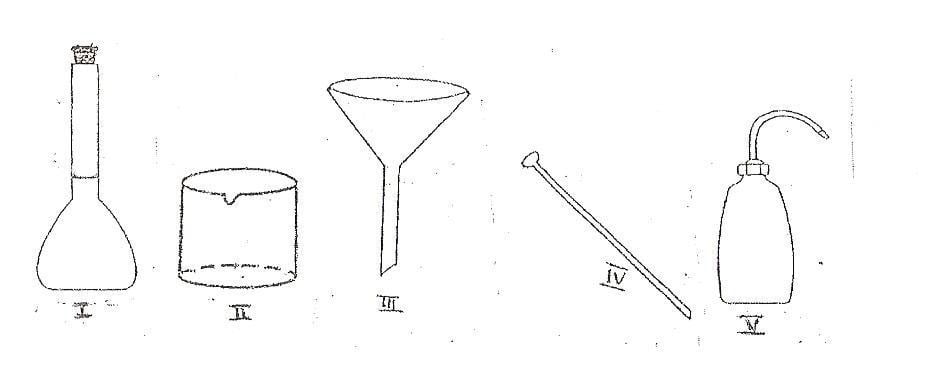
(i) Name each of the apparatus labeled I,II,III, IV and V.
(ii) State one function of each of the apparatus labeled I, II, III, IV and V. (c) The diagram below is an illustration of the external features of a flowering plant.
Study it carefully and use it to answer the questions that follow
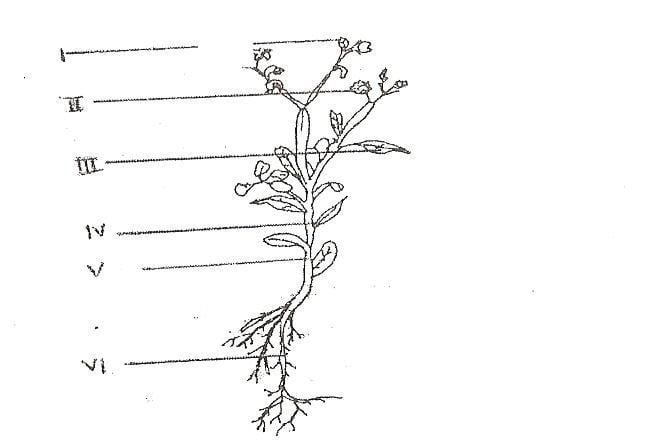
(i) Name the parts labeled I,II, III, IV, V and VI
(ii) State one function of each of the parts labeled I, II, III, V and VI
(iii) State the two main parts of a flowering plant
(d) The diagram below is an illustration of a small farm animal.
Study it carefully and use it to answer the questions that follow
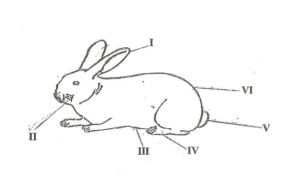
(i) Identify the animal
(ii) Name each of the parts of the animal labeled I, II,III, IV, V and VI
(iii) Name the structure in which the animal is kept
(iv) Mention three breeds of the animal.
(v) State two management practices to be adopted in order to control diseases and pests in the rearing of the animal.
PART II [60 marks]
Answer four questions only from this part
2.(a)(i)What is technology?
(ii) State one use of technology in communication
(b) Write and balance each of the following chemical equations:
(i) Fe+O2→Fe2O3;
(ii) Na+Cl2→NaCl;
(iii) H2+O2→H2O
(c) State one function of each of the following components of atypical cell:
(i) nucleus; (ii) chloroplast; (iii) mitochondrion
(d) Mention four cultural practices in vegetable crop production
(e) Name two agencies in food safety and quality assurance in Ghana.
3. (a) Explain why a tomato plant is likely to wilt if too much fertilizer is applied to it.
(b) (i) Give two differences between electrical insulators and electrical conductors.
(ii) State two effects of illegal electrical connections in the home.
(c) Explain each of the following terms as used to describe change of state of matter:
(i) condensation;
(ii) freezing
(d) (i) State two diseases of the circulatory system in humans
(ii) Mention two ways in which each of the diseases you have stated in (d)(i)can be prevented.
4. (a) (i) What is a transistor?
(ii) Give two uses of a transistor
(b) Mention the suitable solvent for each of the following solutes:
(i) grease;
(ii) ink stain
(iii) starch
(iv)cube sugar
(v)oil paint
(vi) iodine
(c)(i)What is a respiratory organ?
(ii)Name two structures of the respiratory system of humans.
(d)(i)What is agricultural chain?
(ii)Name two types of agricultural chain
5. (a) (i)What are stars?
(ii) Arrange in order, starting from the sun, the first four planets in the solar system.
(b)State
(i)two differences between plants and animals;
(ii) two similarities between plants and animals
(c) Explain each of the following farming systems:
(i) pastoral farming
(ii) ecological farming
(d) State the properties of water in terms of
(i) odour, (ii) taste, (iii) effect on litmus
6. (a) What are
(i) annual plants?
(ii) perennial plants?
(b) Mention one danger involved in each of the following activities in the laboratory:
(i) eating or drinking water in the laboratory;
(ii)washing hands with unknown liquid in a beaker;
(iii)walking bare footed.
(c)(i) What is a digestive enzyme?
(ii)Give two examples of digestive enzymes in humans.
(d) Give two differences between conduction and radiation of heat
CLICK TO VIEW ANSWERS TO PART 2

